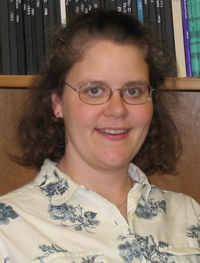Kristan Corwin
If you can read this, your browser is unable to properly import or use
Cascading Style Sheets (CSS). Please upgrade to a more modern browser.

Kristan Corwin
(Now head of the Applied Physics Division at NIST)Ph.D. Physics, 1999, University of Colorado
Contact Information:
- Phone: 785-532-1663
- e-mail: corwin@phys.ksu.edu
- Web: http://www.phys.ksu.edu/personal/corwin/
Research Interests:
Optical frequency metrology using ultrafast lasers; Supercontinuum generation
Please visit the Physics Department for teaching and class information.
I specialize in frequency metrology and gas-filled photonic bandgap optical fibers. In my lab, we are using the Nobel-prize-winning technology of optical frequency combs to measure the optical frequencies at which molecular gases absorb light. The gas is contained inside hollow optical fibers, making it potentially portable and extremely robust. These systems are excellent candidates for new frequency standards that are important to the telecommunications industry.
We confine molecular gases in novel hollow optical fiber, such as photonic bandgap fiber, or more recently "kagome" fiber from our collaborators at the University of Bath. Our group is among the first to observe narrow, "sub-Doppler" features in saturated absorption spectroscopy inside these fibers. The sub-Doppler absorption features get narrower with increasing core size, making larger-core fibers better for optical frequency references. We have developed novel splicing techniques to seal gases inside the fiber. We have locked stable fiber lasers to these lines, and determined the accuracy and stability of that laser. This stabilization technique is competitive with the potentially less portable stable optical cavities.
To measure the optical frequency of these features, we compare the locked laser to a stabilized optical frequency comb from Prof. Brian Washburn’s laboratory. This fiber comb is created from a pulsed, or "mode-locked" fiber laser. The regularly spaced train of pulses emitted by this laser, when viewed in the frequency domain (obtained with a Fourier transform), is comprised of a regularly spaced "ruler" of optical frequencies. To reference that "ruler", we lock our comb to a precise time standard, specifically a combination of a GPS receiver and a Rb clock. This comparison reveals that the stability of the reference is ~ 10-11 in 1 sec, which is as high as many length references. The accuracy and stability of the resulting comb is limited by the GPS reference alone.
We are also pursuing other solid-state laser-based frequency combs, such as Cr:forsterite. In particular, we are studying the unique noise properties of the Cr:forsterite frequency comb, which may give insights into frequency comb noise in general and prove helpful in creating more stable frequency combs in the future. We have achieved unusually narrow "beat note" signals in locking our Cr:forsterite laser, and surprising dynamics of the comb noise.
Recent Publications:
Access to journal links may be restricted to subscribers.
The
KSU Math/Physics Library
offers an extensive collection of journal links.
Last updated on Tuesday, 02-Apr-2019

